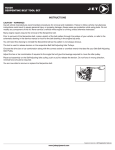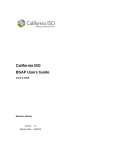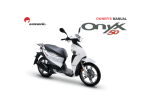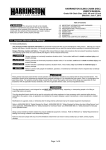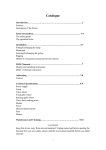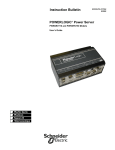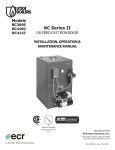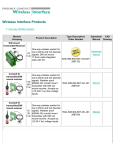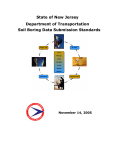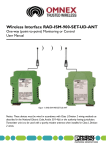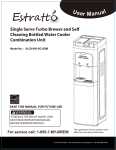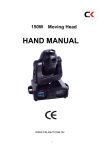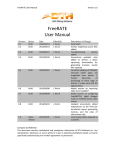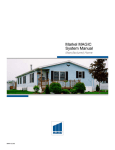Download JET L-90 1/2
Transcript
OPERATOR'S MANUAL L90 MODEL CHAIN HOISTS ½TON THROUGH 10 TON BRANCHES: Vancouver 3260 Production Way Burnaby, B.C. V5A 4W4 Tel:(604) 444-5300 Toll free:1-800-472-7685 Fax:(604) 444-9227 Edmonton 4120 - 78 Avenue NW Edmonton, Alberta T6B 3M8 Toll free: Tel: 1-800-468-1628 Fax: 1-800-663-7742 Winnipeg 951 Powell Avenue Winnipeg, Manitoba R3H 0H4 Tel:(204) 632-6970 Toll free:1-800-665-7524 Fax:(204) 694-9534 Toronto 416 Watline Avenue Mississauga, Ontario L4Z 1X2 Tel:(905) 502-8665 Toll free:1-800-387-3879 Fax:(905) 502-7707 www.jetequipment.com Montreal 4620 rue Garand St-Laurent, Quebec H4R 2A2 Sans frais: Tel:1-800-363-2885 Fax:1-800-267-3310 Halifax #123-11 Morris Drive Dartmouth, Nova Scotia B3B 1M2 Tel:(902) 468-8324 Toll free:1-800-472-7686 Fax:(902) 468-3461 TABLE OF CONTENTS WARRANTY POLICY . . . . . . . . . . . . . . . . . . . . . . . . . . . . . . . . . . . . . . . . . . . . . . . . . . . . . . . . . . . . . . . . INFORMATION FOR YOUR SAFETY . . . . . . . . . . . . . . . . . . . . . . . . . . . . . . . . . . . . . . . . . . . . . . . . . . . . . . PRIOR TO INSTALLATION . . . . . . . . . . . . . . . . . . . . . . . . . . . . . . . . . . . . . . . . . . . . . . . . . . . . . . . . . . . . . SAFETY PRECAUTIONS . . . . . . . . . . . . . . . . . . . . . . . . . . . . . . . . . . . . . . . . . . . . . . . . . . . . . . . . . . . . . . INSPECTION AND MAINTENANCE . . . . . . . . . . . . . . . . . . . . . . . . . . . . . . . . . . . . . . . . . . . . . . . . . . . . . . HOOKS . . . . . . . . . . . . . . . . . . . . . . . . . . . . . . . . . . . . . . . . . . . . . . . . . . . . . . . . . . . . . . . . . . . . . . . . . . . CHAIN . . . . . . . . . . . . . . . . . . . . . . . . . . . . . . . . . . . . . . . . . . . . . . . . . . . . . . . . . . . . . . . . . . . . . . . . . . . PARTS BREAKDOWN . . . . . . . . . . . . . . . . . . . . . . . . . . . . . . . . . . . . . . . . . . . . . . . . . . . . . . . . . . . . . . . . 1 1 2 2 3 4 5 6 ONE YEAR LIMITED WARRANTY JET™ Manual Hoists are guaranteed to be free of defects in material and workmanship. If one of these products fails during the first year of operation due to defective material or workmanship it will be repaired or replaced at our discretion. Normal wear and tear on moving parts is excluded from this guarantee. This guarantee does not apply to any product showing signs of misuse, overloading, alteration, or improper maintenance. WARRANTY PROCEDURE After receiving authorization from one of the offices listed below, any product for which there is a warranty claim must be returned prepaid to an authorized JET™ warranty depot along with proof of purchase. Addresses for information on JET™ Material Handling products, warranty depots or distributors: Vancouver 3260 Production Way Burnaby, B.C. V5A 4W4 Tel: (604) 444-4336 Fax: (604) 444-9227 Edmonton 4120 - 78 Avenue NW Edmonton, Alberta T6B 3M8 Tel: (403) 468-1618 Fax: (403) 466-9879 Winnipeg 1326 Border Street Winnipeg, Manitoba R3H 0M8 Tel: (204) 632-6970 Fax: (204) 694-9534 Toronto 6830 Rexwood Road Mississauga, Ontario L4V 1L8 Tel: (905) 677-2103 Fax: (905) 677-8008 Montreal 4620 Rue Garand St-Laurent, Quebec H4R 2A2 Tel: (514) 332-4612 Fax: (514) 332-4777 Halifax #123-11 Morris Drive Dartmouth, Nova Scotia B3B 1M2 Tel: (902) 468-8324 Fax: (902) 468-3461 INFORMATION FOR YOUR SAFETY It is the responsibility of the owner/user to install, inspect, test, maintain, and operate these hand chain hoists in accordance with ASME B30.16, Safety Standard for Overhead Hoists. These general instructions deal with the normal installation, operation and maintenance situations encountered with the hand chain hoists described herein. The instructions should not be interpreted to anticipate every possible contingency or to anticipate the final system or configuration that uses these hand chain hoists. These instructions include information for a variety of hand chain hoists. Therefore, all instructions and information may not apply to one specific hand chain hoist. Disregard those portions of the instructions that do not apply. If the hand chain hoist owner/user requires additional information, or if any information in these instructions is not clear, contact your local JET ™ chain hoist distributor. This hand chain hoist should not be installed, operated, or maintained by any person who has not read all the contents of these instructions, and ASME B30.16, Safety Standard for Overhead Hoists. Failure to read and comply with these instructions or any of the warnings or limitations noted herein can result in serious bodily injury or death, and/or property damage. Only trained and qualified personnel shall operate and maintain this equipment. Equipment described herein is not designed for, and should not be used for lifting, supporting, or transporting people. User should not use this hand chain hoist in conjunction with other equipment unless necessary and/or required safety devices applicable to the system are installed by the user. Modifications to upgrade, rerate or otherwise alter these hand chain hoists shall be authorized only by the original equipment manufacturer or qualified professional engineer. 1 PRIOR TO INSTALLATION Check for damage during shipment. Place claim with carrier if any damage is discovered. DO NOT install or use a damaged hand chain hoist. Check and verify that structure or other equipment that will support the hand chain hoist has a rated load capacity equal to or greater than the rated load capacity of the hand chain hoist to be used. OPERATION Before initital operation of hoist: 1. Read and comply with all instructions and warnings furnished with or attached to hoist. 2. Check lubricant. 3. Check operation of brake. 4. Check that chain is properly seated in sheaves and that chain is not twisted, kinked, or damaged. Before each shift: 1. Inspect hooks for nicks, gouges, cracks, and signs of pulling apart or twisting. 2. Inspect hook latch for proper operation. 3. Check chain for kinks or twists. 4. Check operation of brake. 5. Replace warning label if missing or illegible. Before operating: 1. Be certain all personnel are clear of the load to be lifted and moved. 2. Make sure load will clear stock piles, machinery, or other obstructions when hoisting and travelling the load. 3. Eliminate any twists or kinks in the load chain. SAFETY PRECAUTIONS A. READ these instructions and ASME B30.16, Safety Standard for Overhead Hoists before installing, operating, or maintaining this equipment. B. WARN personnel of approaching loads. C. DO NOT 1. Lift more than rated load. 2. Operate hoist when it is restricted from forming a straight line with the direction of loading. 3. Operate with twisted, kinked, or damaged chain. 4. Operate if chain is not seated in sheaves or sprockets. 5. Wrap chain around load or use chain as a sling. 6. Operate unless load is properly applied to the saddle or bowl of the hook. 7. Operate if load is applied to the tip of the hook. 8. Operate with damaged or missing hook latches. 9. Lift people or lift loads over people. 10. Operate with side-pulling or side-loading of load to hoist. 11. Operate a damaged or malfunctioning hoist. 12. Operate with other than hand power. 13. Remove, deface, or obscure warning label or labels on hoist. 14. Leave load suspended when hoist is unattended unless specific precautions have been instituted and are in place. 15. Lengthen load chain or repair damaged load chain by welding. 16. Use chain as a ground for welding. 2 INSPECTION AND MAINTENANCE Prior to initial use, all new, modified, and repaired hoists shall be inspected in accordance with Table 2. Thereafter, inspections shall be conducted at intervals shown in Table 1; and items to be inspected are indicated in Table 2 by F (Frequent) or P (Periodic). Frequent Inspections - Visual inspection by the oeprator or other authorized person. This inspection includes listening for unusual sounds while the hoist is operated that may indicate deficiencies. Periodic Inspections - Audible-visual inspection as for Frequent Inspections, with some disassembly to allow a more detailed inspection if external conditions indicate the need. Exception: Brakes require more than audible-visual inspection. Check daily by operating hoist with and without load, stopping at various positions to test holding power and amount of drift, if any occurs. TO ADJUST BRAKE (Refer to Figure 1): 1. Fully tighten nut to position A. 2. Slack off nut from position A to position B and insert cotter key. TABLE 1 - FREQUENCY OF INSPECTION SERVICE FREQUENT (F) INSPECTION PERIODIC (P) INSPECTION Normal Monthly Annually Heavy Weekly to Monthly Semi-Annually Severe Daily to Weekly Quarterly TABLE 2 - INSPECTION CHART In chart, F indicates Frequent Inspection, P indicates Periodic Inspection LOCATION Braking mechanism CHECK FOR F Slipping under load T Hard to release T P LOCATION Brake Parts P T Not tight or secure Hook Latch Damaged; does not close Excessive wear Distortion T Broken or worn teeth T T Oil contamination T Suspension Members (Sheaves,hand-wheels, chain attachments, suspension bolts or pins) Pawl; Ratchet Excessive wear T Gears Pawl Spring Corrosion; stretch T Hooks F Hook Retaining Members (Pins, Bolts, Nuts) Glazing Brake Discs CHECK FOR Cracks T T T T Chemical damage T Cracks T Deformation T Inadequate lubrication T 5% in excess of normal throat opening T 10E twist from plane of unbent hook T Cracks (dye penetrant, magnetic particle, or other suitable detection method) T Load Block; Suspension Housing Distortion T T Cracks T T Trolley; Supporting Structure Possible inability to continue supporting imposed loads T Bolts, Nuts, Rivets Not tight or secure T WARNING Label Removed or illegible Refer to ASME B30.16 for additional information on inspection, test, and maintenance. 3 T HOOKS WARNING 1. Any hook that requires replacement because of excessive bends, twists, or throat opening indicates abuse or overloading of the hoist. Therefore, other load-supporting components of the hoist should be inspected for possible damage when such conditions are found. 2. Never repair hooks by welding or reshaping. Heat applied to the hook will alter the original heat treatment of the hook material and reduce the strength of the hook. 3. Never weld handles or other attachments to the hook. Heat applied to the hook will alter the original heat treatment of the hook material and reduce the strength of the hook. HOOKS INSPECTION Refers to ASME B30.10, Safety Standard for Hooks. Inspect hooks and measure hook throat opening at least once a month. Between regular inspections check visually daily for deformation, distortion, twisting, damage, and missing or damaged hook latches. Inspect as follows: 1. Measure hook throat opening from metal to metal of the hook as shown by dimension g in Figure 2. DO NOT measure from latch to metal. Hook must be replaced when throat opening measurement has increased 5% over the original throat opening dimension of a new hook, as follows: CAPACITY TONS DIMENSION g NEW HOOK DIMENSION g REPLACE HOOK 1/2 30mm 31.5mm 1 34mm 35.7mm 1-1/2 39mm 40.9mm 2 43mm 45.2mm 3 50mm 52.5mm 5 58mm 60.9mm 10 70mm 73.5mm 2. Measure hook depth at load bearing point (base, bowl or saddle) of the hook. Hook must be replaced when wear at load bearing point is 10% of the original depth of the hook load bearing point. 3. A bend or twist of the hook exceeding 10E from the plane of the unbent hook requries replacement of the hook. 4. A hook latch that is missing shall be replaced. 5. A hook latch that is inoperative shall be repaired or replaced. 6. A hook with a hook latch that does not close the throat opening of the hook shall be removed from service until the latch is replaced or repaired. 7. Hooks having damage from chemicals, corrosion, or deformation shall be repaired or replaced. 4 CHAIN Inspect chain at least once a month. Between regular inspections, check visually daily for nicks, gouges, weld splatter, corrosion, or distorted links. Inspect chain thoroughly if it does not feed smoothly over load sheaves. Inspect as follows: 1. Clean chain with solvent before inspection. 2. Test hoist with load and observe operation of chain over load sheaves. 3. Slacken chain and inspect contact points for excessive wear. Refer to Figure 3. 4. Using caliper-type gauge, measure inside length of 5 links under light tension. Refer to Figure 4. Replace chain if measurement exceeds maximum allowable gauge length as follows: CAPACITY TONS CHAIN WIRE DIAMETER 5 LINKS NORMAL 5 LINKS MAXIMUM 1/2 5.0mm 75mm 77.6mm 1 6.3mm 95mm 98.3mm 2 8.0mm 120mm 124.1mm 1-1/2 and 3 7.1mm 105mm 108.6mm 5 and 10 9.0mm 135mm 139.6mm INSTALLING LOAD CHAIN WARNING: DO NOT ADD TO LOAD CHAIN; REPLACE ENTIRE CHAIN To install load chain into load chain sprocket: 1. Position load chain sprocket by rotating handchain wheel so that wide and narrow grooves show. 2. Using a forked poker, insert top chain link into sprocket grooves so that chain will wind up and back over sprocket. Welds must be away from sprocket. 3. Rotate handchain wheel so that load chain winds around sprocket. Stop when chain falls 6 to 8 inches at back of sprocket. 4. Attach end link of the load chain to the chain anchor. To install load chain anchor when replacing old chain: 1. Remove cotter pin and chain anchor pin on chain anchor. 2. Insert bottom chain link into chain anchor. 3. Insert chain anchor pin through anchor brackets and chain link. 4. Insert cotter pin through hole in anchor pin and secure. To install load chain into lower hook (1/2, 1, 1-1/2, and 2 ton): 1. Remove cotter pin from castle nut and remove nut. 2. Insert last chain link into lower hook slot. Check that chain is not twisted. 3. Insert chain bolt into lower hook slot. 4. Insert chain bolt through lower hook slot and chain link. 5. Secure castle nut to end of bolt. 6. Insert cotter pin into castle nut and secure. To install load chain into lower hook (3, 5, and 10 ton): 1. After installing load chain into load chain sprocket, run remaining chain through hands, removing any twist. Last link of chain must be in same direction as first. If not, cut off last link. 2. Insert last link into left-hand pulley of lower hook. Pull chain through and up from underside of pulley. 3. Check that chain stopper is on right-hand side. 4. Insert last link into right-hand pulley of upper hook, moving chain up, back, then down. Check that chain is not twisted and welds face away from pulley. 5. Insert last link into right-hand pulley of lower hook, pulling up from underside of pulley. Check that chain is not twisted. 6. Insert last link over left-hand pulley of upper hook, moving chain up, back, then down. 7. To prevent free-wheeling of chain, insert screwdriver securely into link at base of upper pulley. 8. Remove cotter pin, castle nut, and chain bolt in lower hook slot. 9. Insert last link into slot. 10. Check that chain is not twisted. 11. Position bolt back through lower hook slot and last chain link. 12. Place castle nut onto end of bolt. 13. Secure cotter pin in tapered hole of bolt. 14. Remove screwdriver from link at base of upper pulley. Install load chain for 3 ton and 5 ton hoists in same manner as above but allow for fewer falls of chain. 5 6 L-90 1/2 TON - 5 TON MODEL ITEM# DESCRIPTION 001 002 003 007 015 016 TOP HOOK ASSY GEAR SIDE PLATE ASSY WHEEL SIDE PLATE ASSY LOAD SHEAVE ASSY BOTTOM HOOK ASSY SAFETY LATCH ASSY (OLD STYLE) SAFETY LATCH ASSY (NEW STYLE) GEAR CASE ASSY 2ND & 3RD GEAR ASSY STRIPPER ASSY TOP HOOK PIN STAY BOLT COVER NUT WASHER HAND WHEEL COVER CHAIN STOP PIN ANCHOR PLATE ANCHOR PLATE PIN DRIVING SHAFT DRIVING SHAFT WASHER LOAD GEAR CASTLE NUT CASTLE NUT PIN LOAD METAL LOAD SHEAVE COVER LOAD SHEAVE COVER PIN HAND CHAIN WHEEL DISC HUB RATCHET GEAR FRICTION DISC CHECK WASHER PAWL PAWL PIN PAWL SPRING BRAKE COVER FRICTION DISC CHAIN STOP BOLT ASSY NAME PLATE RIVET 023 024 027 105 203 205 206 218 221 225 226 301 302 305 308 312 404 405 433 501 505 506 507 508 510 511 512 513 517 604 940 941 BE SURE TO STATE TONNAGE WHEN ORDERING PARTS L-90 10 TON MODEL ITEM# 001 002 003 007 015 016 023 024 027 105 203 205 206 218 221 225 226 301 302 305 308 312 404 405 433 501 505 506 507 508 510 511 512 513 517 604 940 941 DESCRIPTION TOP HOOK ASSY GEAR SIDE PLATE ASSY WHEEL SIDE PLATE ASSY LOAD SHEAVE ASSY BOTTOM HOOK ASSY SAFETY LATCH ASSY GEAR CASE ASSY 2ND & 3RD GEAR ASSY STRIPPER ASSY TOP HOOK PIN STAY BOLT COVER NUT WASHER HAND WHEEL COVER CHAIN STOP PIN ANCHOR PLATE ANCHOR PLATE PIN DRIVING SHAFT DRIVING SHAFT WASHER LOAD GEAR CASTLE NUT CASTLE NUT PIN LOAD METAL LOAD SHEAVE COVER LOAD SHEAVE COVER PIN HAND CHAIN WHEEL DISC HUB RATCHET GEAR FRICTION DISC CHECK WASHER PAWL PAWL PIN PAWL SPRING BRAKE COVER FRICTION DISC CHAIN STOP BOLT ASSY NAME PLATE RIVET










